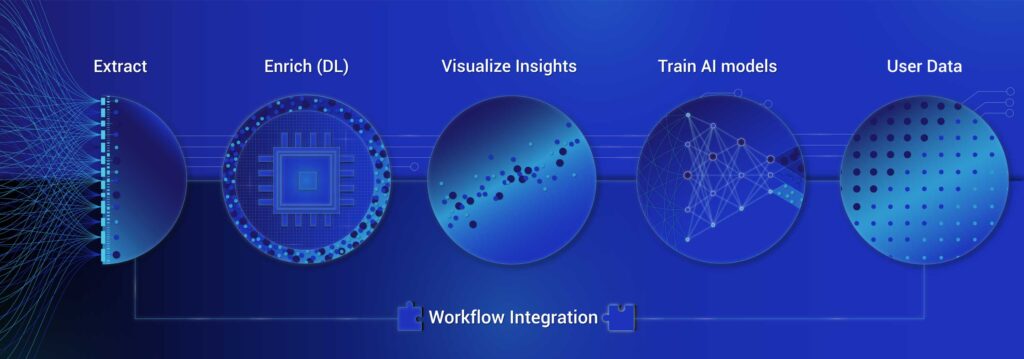Published on 21.05.2025
Accelerating Energy Materials Discovery with AI: The Success Story of UTILE

How Autonomous Image Analysis is Transforming Energy Research
Clean energy technologies hold the key to a sustainable future. Yet, the road from materials discovery to device integration is often paved with slow, manual processes, especially when it comes to analyzing complex imaging data from advanced characterization methods. The Helmholtz Imaging project UTILE has set out to change this.
UTILE, short for “aUTonomous Image anaLysis to accelerate the discovery and integration of energy matErials”, has successfully developed an innovative data platform that automates and enhances the analysis of imaging data across the energy materials community. Its mission: to accelerate the development of green energy materials and relieve researchers from tedious manual image analysis tasks. As the name suggests (from Latin utile, meaning useful), the project has proven to be just that: useful, usable, and impactful.
The Challenge: Manual Analysis Slowing Down Clean Energy Innovation
Whether it’s oxygen bubble evolution in water electrolyzers, nanoparticle segmentation in microscopy, or bubble dynamics in redox flow batteries, imaging plays a central role in understanding and improving energy materials. Traditionally, the analysis of these images has required significant manual labor by experienced researchers, a bottleneck in scaling up the discovery process.
“We need to understand how a lab technician analyzes the images, how they’re thinking, what they’re looking for,” explains Dr. Kourosh Malek, Department Head of Artificial Materials Intelligence at Forschungszentrum Jülich (FZJ), IET-3, and project coordinator of UTILE. This cognitive knowledge, combined with advances in cloud computing, will be translated into pre-trained algorithms that can use deep learning to continually draw new conclusions from both existing data and data that will be added in the future.
The Solution: AI-Powered Tools for Automated Image Analysis
UTILE delivered on its promise by developing five software solutions:
- UTILE-Meta: A collaborative imaging metadata standardization approach that combines domain-specific LLM-ontology alignment with the power of graph databases to store the data.
- UTILE-Redox: A deep learning-based framework for the autonomous multi-class segmentation and feature extraction of hydrogen bubbles inside Vanadium Redox Flow Batteries (VRFBs) from Synchrotron X-ray tomographies.
- UTILE-Pore: A general 3D deep learning approach for the elucidation of 3D porous structures from materials related to polymer electrolyte membrane technologies.
- UTILE-Oxy: A deep learning-based tool for automatic analysis of oxygen evolution videos in polymer electrolyte membrane water electrolyzers (PEMWE).
- UTILE-Gen: A synthetic dataset generator for nanoparticle imaging, eliminating the need for manual annotation and enabling the training of high-performance deep learning models.
These tools are embedded in a cloud-based platform (ViMiLabs), allowing global access to pre-trained models, real-time data analysis, and powerful visualization capabilities. The integration of metadata standardization protocols developed in the UTILE-Meta subproject and FAIR data principles ensures that the platform fosters interoperability and reusability across research institutions.
“We believe in open, collaborative research,” emphasizes André Colliard-Granero, PhD candidate and key contributor to UTILE. “By connecting labs worldwide through our platform, we enhance the efficiency of materials characterization and support the rapid development of energy materials for advanced energy conversion and storage technologies.”

Impact and Achievements: Publications, Patents, and Real-World Benefits
The project not only delivered innovative software solutions but also achieved impressive scientific and technological milestones:
- 5 published resources, including peer-reviewed articles, such as “UTILE-Gen: Automated Image Analysis in Nanoscience Using Synthetic Dataset Generator and Deep Learning” (ACS Nanoscience Au), “Deep learning-enhanced characterization of bubble dynamics in proton exchange membrane water electrolyzers” (Physical Chemistry Chemical Physics) and UTILE-Pore: Deep Learning-Enabled 3D Analysis of Porous Materials in Polymer Electrolyte Membrane-Based Energy Devices (Journal of The Electrochemical Society).
- 2 patent registrations demonstrating the novelty and applicability of the developed methods.
- Integration into international networks like the German-Canadian Materials Acceleration Centre (GC-MAC) and the REACH2 initiative, boosting global collaboration on clean hydrogen technologies.
- 1 Spin-off called ViMiLabs, a cloud-based platform with AI model deployment and inference capabilities that integrates the developed tools from the UTILE project and aims to keep the project alive by promoting further model maintenance, tool development, standardized data management, and community-based collaboration across the energy materials field.
“The UTILE project showcases how AI-enabled analysis tools can significantly speed up the process, from the discovery stage to the deployment of these materials in real-world applications,” says Malek. “ViMi.ai employs advances in agentic AI to make scientific discovery 10 times faster and 80% cheaper. It opens new avenues for accelerated research and development for novel energy systems, aiding in the optimization of their design and enhancing their performance.”
Added Value for the Scientific Community
UTILE’s greatest contribution lies in its scalable, flexible, and user-oriented approach. Researchers can now access ready-to-use machine learning models for various imaging scenarios without being machine learning experts themselves. The cloud platform ensures that data from different characterization techniques – from electron microscopy to synchrotron X-ray tomography – can be analyzed, compared, and shared across disciplines and borders.
“This project empowers the community with tools that are adaptable and continuously improving,” highlights Colliard-Granero. “We designed the platform to be agnostic – it’s not limited to one use case but can easily be extended to challenges from different fields.”
A Foundation for Future Innovation
With a robust metadata framework and knowledge graphs in development, UTILE paves the way for future applications beyond its current focus. The next steps include:
- Implementation of robust data ontologies integrated into a native graph database (Neo4j), improving imaging data searchability and supporting systematic model training and complex image analysis.
- Development of an API for seamless data ingestion from diverse sources, enhancing the platform’s capabilities for handling large-scale imaging datasets and facilitating real-time global collaboration.
- Expansion into new research areas and use cases, bringing more Helmholtz Centers and international partners on board.
The UTILE project stands as a prime example of how machine learning and data-driven solutions can significantly accelerate scientific progress, ultimately contributing to the global race toward a clean energy future.
Key Takeaway
UTILE has demonstrated how harnessing AI for autonomous image analysis can break down traditional barriers in energy materials research and development. By reducing manual workload by a factor of 10x, and increasing reproducibility and accuracy, UTILE allows scientists to focus on what they do best: innovating for a sustainable tomorrow.